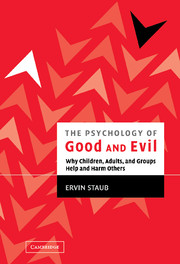Book contents
- Frontmatter
- Contents
- Preface
- Acknowledgments
- PART I INTRODUCTION AND CORE CONCEPTS
- 1 Good and Evil: Themes and Overview
- 2 Studying the Pivotal Role of Bystanders
- 3 Studying and Promoting Altruism and Studying and Working to Prevent Genocide: The Guiding Role of Early Survival
- 4 Is Evil a Useful Concept for Psychologists and Others?
- 5 Basic Human Needs and Their Role in Altruism and Aggression
- PART II THE ROOTS OF HELPING OTHER PEOPLE IN NEED IN CONTRAST TO PASSIVITY
- PART III HOW CHILDREN BECOME CARING AND HELPFUL RATHER THAN HOSTILE AND AGGRESSIVE
- PART IV THE ORIGINS OF GENOCIDE, MASS KILLING, AND OTHER COLLECTIVE VIOLENCE
- PART V THE AFTERMATH OF MASS VIOLENCE: TRAUMA, HEALING, PREVENTION, AND RECONCILIATION
- PART VI CREATING CARING, MORALLY INCLUSIVE, PEACEFUL SOCIETIES
- Appendix: What Are Your Values and Goals?
- Index
- References
5 - Basic Human Needs and Their Role in Altruism and Aggression
Published online by Cambridge University Press: 07 May 2010
- Frontmatter
- Contents
- Preface
- Acknowledgments
- PART I INTRODUCTION AND CORE CONCEPTS
- 1 Good and Evil: Themes and Overview
- 2 Studying the Pivotal Role of Bystanders
- 3 Studying and Promoting Altruism and Studying and Working to Prevent Genocide: The Guiding Role of Early Survival
- 4 Is Evil a Useful Concept for Psychologists and Others?
- 5 Basic Human Needs and Their Role in Altruism and Aggression
- PART II THE ROOTS OF HELPING OTHER PEOPLE IN NEED IN CONTRAST TO PASSIVITY
- PART III HOW CHILDREN BECOME CARING AND HELPFUL RATHER THAN HOSTILE AND AGGRESSIVE
- PART IV THE ORIGINS OF GENOCIDE, MASS KILLING, AND OTHER COLLECTIVE VIOLENCE
- PART V THE AFTERMATH OF MASS VIOLENCE: TRAUMA, HEALING, PREVENTION, AND RECONCILIATION
- PART VI CREATING CARING, MORALLY INCLUSIVE, PEACEFUL SOCIETIES
- Appendix: What Are Your Values and Goals?
- Index
- References
Summary
A number of psychological theories include assumptions about central human needs. A few theories have focused on universal human needs. However, even though the need theories of Maslow and Murray are part of most personality psychology textbooks, human needs theory has not gained much prominence in psychology. Perhaps the reason is that the role of human needs in psychological functioning has not been extensively examined.
If there are basic, universal psychological needs, they must have a substantial role in human life. The purpose of this chapter is to offer a conception of basic psychological needs. They are important for this book because, in my view, the frustration of basic needs is central in the development of hostility and aggression, while their fulfillment is central in the development of caring about other people's welfare and altruism. While the work presented in this book is in no way dependent on a conception of basic needs, I believe that such a conception provides a useful framework for understanding helping and harm-doing.
basic psychological needs
One of the deepest concerns of psychologists and some other social scientists has been the identification of the springs of human action. What moves us to action and/or determines the direction of our strivings? Our motives, described by concepts like needs, desires, aims, goals and aspirations, not only shape our actions, but their fulfillment or frustration also deeply affect our inner life, our experience of ourselves and the world. Basic needs are conceptualized here as the most fundamental motives.
- Type
- Chapter
- Information
- The Psychology of Good and EvilWhy Children, Adults, and Groups Help and Harm Others, pp. 52 - 68Publisher: Cambridge University PressPrint publication year: 2003
References
- 3
- Cited by

